HMS Bulolo—No. 1 Ship Signal Section, 1942-1945 (Part 2)
Part 1 of this tale covered the period from the formation of No. 1 Ship Signal Section in 1942 until the arrival of HMA Bulolo in Bombay (Mumbai) in September 1943.
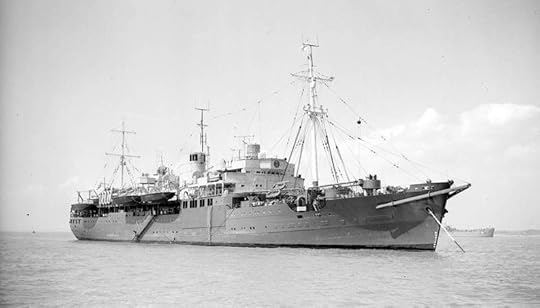
HMS Bulolo
HMS Bulolo’s deployment to the Far East in the latter part of 1943 was in preparation for amphibious operations in the late spring of 1944 against Japanese-occupied Sumatra and Malaya (Operation Culverin) and against the Andaman Islands (Operation Buccaneer). The plans were ultimately abandoned but not before No. 1 Ship Signal Section had spent time passing on its experience to new signal sections of the newly-formed 218 Signal Assault Wing.[1] In October, Bulolo took part in a command post exercise with the staff of 33rd Indian Corps (Exercise Otter) that simulated a divisional landing, with the staff from 36th Indian Division and 29th Infantry Brigade on board HMS Keren—the former being described as, ‘completely satisfactory’ but the latter (i.e. embarked division and brigade headquarters) as, ‘a complete failure’.[2] A similar event (Exercise Swordfish) was conducted with 2nd Division the following month, by which time the lessons had been learned and communications were much improved. A third exercise was cancelled in mid-December and Bulolo was ordered back to the Mediterranean. After spending Christmas at Bombay, she sailed for Italy via the Suez Canal.
Bulolo arrived at Naples on 12 January 1944 and immediately embarked Lieutenant Colonel L. T. Shawcross, commanding officer of 1st Divisional Signals. The division had been allocated to United States VI Corps as one of the two assaulting division for Operation Shingle—an amphibious landing at Anzio. The divisional staff and additional signallers embarked over the following days and on 18 January an exercise was carried out in the Salerno area. On 20 January, an interoperability exercise took place with the headquarters ship USS Biscayne, the flagship for the operation, and the following day the assault force sailed for Anzio.[3] The landings were largely unopposed and, from the perspective of the signal section, somewhat routine. The divisional staff disembarked on 23 January and the following day, in the midst of an air attack, Bulolo sailed for Naples and thence to Malta. March 1944 was spent in Algiers and on 7 April the ship’s company prepared to depart the Mediterranean. Prior to sailing a signal was received from Commander-in-Chief Mediterranean that read: ‘Whilst on Mediterranean Station you have played a very active part in operations and may be justly proud of your share in our successes. Goodbye and good luck to you and your ship’s company’.
Bulolo was now destined for Portsmouth and a refit in preparation for its next task, the Normandy landings. The refit and various administrative activities took up the rest of the month before the ship sailed for Southampton where it embarked the staff of Commodore Sir Cyril Douglas-Pennant CBE, DSO commanding Task Force ‘G’ and began preparations for the first pre-landings exercise, Exercise Fabius, which also involved the commander and staff of 50th (Northumbrian) Division. Several days later a communications exercise took place with the divisional signals (Exercise Grab) and then with 30th Corps (Exercise Bargepole), and No. 2 Air Support Signal Unit (Exercise Blarney), all of which were successful. Similar exercise followed at the end of the month. The signal section was briefed on the plan for Operation Overlord on 21 May and on 24 May the ship hosted a visit by King George VI, Admiral Sir Bertram Ramsay KCB, KBE, MVO (Allied Naval Commander-in-Chief), and Rear Admiral Sir Philip Vian KBE, DSO (commanding Eastern Task Force). At the end of the visit the King took the salute at a ‘steam past’ of the landing craft of Force ‘G’.
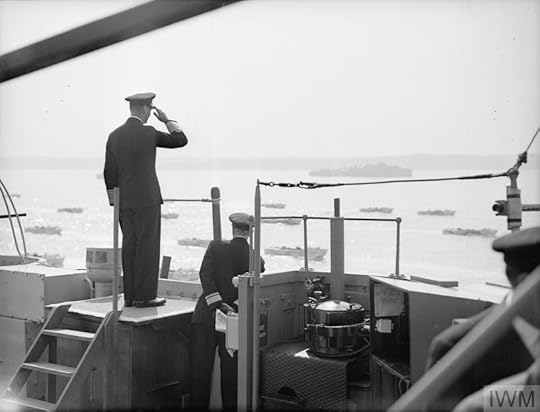
King George VI taking the salute, 24 May 1944.
On 31 May all of the formation operation orders, codes and cyphers for the landings were received and by 2 June the embarked staffs were complete. On board were the staff of Task Force ‘G’; 50th (Northumbrian) Division (Major General D. A. H. Graham DSO, OBE, MC); and the air staff led by Group Captain W. S. P. Simonds DFC. The subordinate assault groups ‘G.1’ (231st Infantry Brigade) and ‘G.2’ (69th Infantry Brigade) were commanded from HMS Nith (with No 15 Ship Signal Section (Modified) embarked) and HMS Kingsmill (No. 14 Ship Signal Section (Modified)), respectively.[4] The follow-on assault group ‘G.3’ comprised 151st and 56th Infantry Brigades, the headquarters for which were on board HMS Albrighton and Landing Craft Infantry (Large) No. 255, both supported by No. 18 Ship Signal Section (Modified).
HMS Bulolo left Southampton for an anchorage in the mouth of the Beaulieu River on 3 June. In the event, the landings were delayed but on the morning of 5 June D-Day was confirmed as being the next day and the landing craft of Force ‘G’ began to move to convoy stations. The workload for the signal section took a sudden upturn that day with over 400 Top Secret packets being delivered to the message centre for despatch.
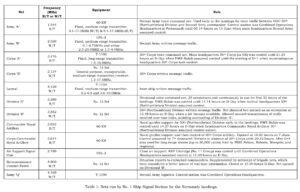
D-Day radio nets (waves) established by No. 1 Ship Signal Section
On D-Day HMS Bulolo sailed with the invasion armada to the French coastline and took up station about six miles off Gold Beach, with the ships providing naval gunfire support arraigned on either flank. Listening watch had been established on the principal nets at 05.30 hours and communications were established as the landing troops opened up on their nets. With the exception of a transmitter fault (soon rectified) on the 30th Corps net, communications from and to Bulolo were excellent throughout the day. Tactical headquarters 50th (Northumbrian) Division proceeded ashore early in the landings and assumed control of the divisional command net at 14.14 hours. Just prior to this, at Hordean at 13.00 hours, the corps commander, Lieutenant General C. G. Bucknall CB, MC, the staff of headquarters 30th Corps, and the GOC’s operators under the command of Second Lieutenant S. Harrison[5] embarked onto HMS Beagle and the destroyer at once sailed for the landing area, where it arrived alongside Bulolo at 18.00 hours. The transfer to Bulolo was complicated by the sea state but by 19.00 hours everyone was on board and the headquarters reconnaissance element was despatched ashore. HMS Bulolo became 30th Corps Main Headquarters at 20.10 hours. Lieutenant General Bucknall went ashore just before midnight. With the arrival of the bulk of the staff and 30th Corps Signals in France the following morning, and after a series of mishaps, the corps headquarters was finally established ashore on the afternoon of 7 June and took control from HMS Bulolo that night.[6]
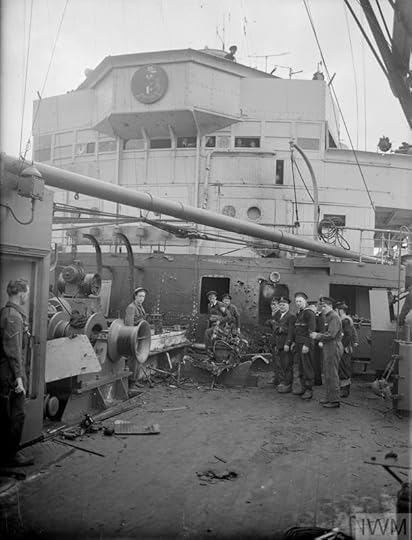
Damage to HMS Bulolo, 7 June 1944
Tragedy struck on the morning of 7 June. At 06.05 hours a 250-lb bomb dropped by one of three attacking FW-190s hit HMS Bulolo and exploded on the port side, forward of the main support control operations room. In addition to the damage inside the operations room, it started a fire on ‘B’ Deck in the officers’ accommodation. The operations room was filled with smoke, with flames coming through the damaged area caused by the explosion, and the sick-bay on the deck beneath the fire was cut off by dense smoke. The sick-bay was badly positioned for use during action stations, however, and the casualties were taken to emergency medical stations in other parts of the ship. The fires were extinguished by 06.45 hours but two RAF signal officers, an RN cypher officer, and a naval gunner had been killed. The RAF officers were in their shared cabin asleep—Flight Lieutenant Bert Drury was killed outright by the blast, and Flight Lieutenant Ken Gate died of his burns a few hours later. The others killed were Sub-Lieutenant Cyril Oaker and Able Seaman George Young. Injured were a Royal Artillery major and two other officers—including the second-in-command of the signal section, Lieutenant F. E. J. Bishop[7]—two sailors and an RAF corporal.[8] The remains of the dead accompanied by a burial party were transferred to HMS Albrighton the following day and they were buried at sea about 10 miles off Queen Red beach.[9] For their conduct during the attack Flight Lieutenant F. D. Johnstone and Corporal F. B. Isles, the wounded RAF NCO, were mentioned in despatches; both were recommended by Group Captain W. S. P. Simonds DFC, who was also mentioned in despatches for his work leading the Force ‘G’ Air Staff.[10]
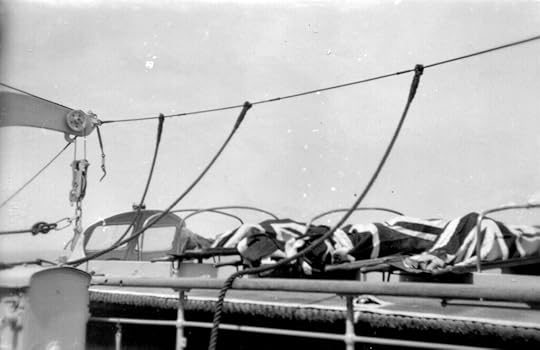
HMS Bulolo’s casualties, 7 June 1944
HMS Bulolo remained off Normandy until the afternoon of 27 June when she sailed for Spithead. After disembarking the staff, the ship remained in the Solent until 5 July when she sailed to Greenock pending a full refit and became an operational reserve. At the end of August she returned to Southampton and work on the extensive refit began. On 30 September, Major Kenworthy was replaced in command of No. 1 Ship Signal Section by Major A. W. L. Moon and took up an appointment as senior instructor at the Combined Operations School (HMS Dundonald II) at Troon.[11]

Sergeant P. A. A. Court MM, BEM
At this stage it is worth recording that Major Kenworthy was mentioned in despatches twice for his command of the section; he had done more than almost anyone in the establishment of the ship signal sections.[12] Notably, Sergeant P. A. A. Court, a Scottish-born, former GPO engineer from Derby who had enlisted in March 1940, was awarded the Military Medal, recommended by the captain of HMS Bulolo, Captain C. A. Kershaw, Royal Navy. Added by Rear Admiral Douglas-Pennant to the original recommendation is the phrase: ‘The example set by this NCO in Operation Neptune was of very high order.’[13] The section’s first second-in-command was also mentioned in despatches; Major K. A. Davis was recognised for his command of No. 3 Ship Signal Section aboard HMS Hilary during the Normandy landings.[14]
No. 1 Ship Signal Section spent its time ashore, most at HMS Dundonald, until the refit was complete in May 1945. HMS Bulolo sailed from Southampton for Greenock on 2 June where it began a series of trails and training exercises. Then, on 12 June, Bulolo departed Greenock for its final wartime deployment and sailed via Gibraltar and the Suez Canal to Bombay, where it arrived on 8 July. By the end of the month exercises had begun with 34th Indian Corps, which had been formed in May 1945 in preparation for Operation Zipper—the invasion of Malaya. The maritime task force, Force ‘W’, assembled at Mandapam at the end of August but the Japanese surrender put paid to the plan and a much modified operation to occupy Malaya was implemented. HMS Bulolo was at Singapore for the surrender ceremony on 12 September and the rest of the month was spent off the coast of Malaya, where control of operations was being exercised from HMS Largs and HMS Persimmon. In early October, the decision was taken to put No. 1 Ship Signal Section ashore and after some deliberation (and disagreement) all but an eight-man section were transferred to the SS Matiana for passage to Columbo, with Major Moon and Lieutenant McCarthy despatched to Bombay. The section reported to the shore station at Colombo, HMS Braganza III, pending disbandment and by the end of the year most men had been sent home. The section was disbanded on 19 December 1945. The final operational award to a member of the section was to Sergeant P. A. A. Court MM who was awarded a British Empire Medal for his work in the Far East, and which noted that he had turned down the opportunity for a commission in order to remain with the section.[15]
HMS Bulolo meanwhile had been despatched to Surabaya in Java (now part of Indonesia) to evacuate 500 Dutch civilian internees, mainly women and children. Decommissioned in December 1946, Bulolo returned to the Australian shipping line Burns Philp, her former owners, and continued to serve as a passenger, cargo, and mail carrier in the south Pacific. She was scuttled in 1951 to extinguish cargo fire but was refloated and repaired, continuing to sail until 1968 when she was scrapped in Taiwan.

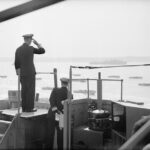
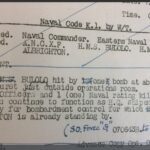
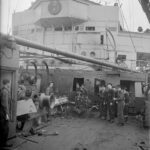
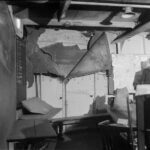

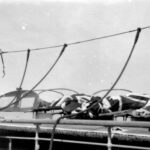

1. (Back) Also referred to in some sources as 218 Combined Operations Signals. Its units were 220th-223rd Indian Ship Signal Sections, each initially comprising two officers and 35 other ranks.
2. (Back) 29th Infantry Brigade had previously been prepared for an amphibious landing at Akyab (Sittwe) in the Arakan. That operation was finally conducted in January 1945 by 3rd Commando Brigade, which had arrived in India in January 1944 in preparation for such an operation.
3. (Back) The landing of United States 3rd Division was commanded from the converted liner RMS Circassia.
4. (Back) HMS Nith was a converted River class frigate and HMS Kingsmill was a United States-built Captain class frigate, the latter being one of several of that type used as various headquarters ships during the landing. The Ship Signal Sections (Modified) were smaller sections, suited to the requirements of a brigade headquarters, comprising one sergeant and 15 other ranks, mostly operators.
5. (Back) Lieutenant Sidney Harrison was appointed an MBE in June 1945 for his endeavours with 30th Corps Signals reconnaissance headquarters during the North-West European Campaign. (LG 21 June 1945; 37138, p. 3220.) Accompanying him on to HMS Bulolo were the GOC’s operators, Corporal J. Turnbull MM and Signalman J. B. Oldendorp.
6. (Back) The detailed report on communications during Operation Overlord by 30th Corps may be found in the Royal Signal Museum Archive.
7. (Back) Lieutenant Bishop left the ship soon after its return to the United Kingdom and was replaced as second-in-command of No. 1 Ship Signal Section by Second Lieutenant Patrick Pearse Kevin McCarthy (14 July 1916-1999).
8. (Back) For details of the attack and the casualties suffered see: Medical Report of Operation ‘Neptune’, Enclosure No. 2 to Section III to Appendix ‘L’ to Report of Naval Commander Force ‘G’, Medical Report of Operation ‘Neptune’, p. 110. Report by the Allied Naval Commander-in-Chief Expeditionary Force on Operation ‘Neptune’, Volume II.
The other injured personnel were:
Major Peter Holliday DobsonPeter Holliday Dobson, Royal Artillery; Sub-Lieutenant (Special Branch) Frederick James Leedham, Royal Naval Volunteer Reserve; D/JX211888 Telegraphist John. W. Robinson, Royal Navy; D/MDX2944 Able Seaman John A Bovill, Royal Navy; and 1519013 Corporal Frank B. Isles, Royal Air Force.
9. (Back) Sub-Lieutenant Cyril Lanham Oaker, Royal Naval Volunteer Reserve is commemorated on the Chatham Naval Memorial; P/JX234664 Able Seaman George Young, Royal Navy is commemorated on the Portsmouth Naval Memorial; 115811 Flight Lieutenant Herbert Drury, Royal Air Force Volunteer Reserve and 115817 Flight Lieutenant Kenneth Gate, Royal Air Force Volunteer Reserve are commemorated on the Runnymede Memorial.
10. (Back) All appear in LG 1 January 1945; 36866.
11. (Back) Major Arthur Walter Letcher Moon (6 October 1908-1969) had been commissioned into Royal Signals in July 1941; his pre-war expertise was in submarine cable telegraphy.
12. (Back) LG 9 November 1944; 36785, p. 5131 and LG 19 July 1945; 37184, p. 3728. The former for Normandy, the latter for the landings in Italy.
13. (Back) Military Medal. 2591601 Sergeant Philip Arthur Alden Court, No. 1 Ship Signal Section. Sergeant Court is the senior NCO of No. 1 Ship Signal Section of the Royal Corps of Signals embarked in HMS Bulolo since September 1942. Throughout the landings in North Africa, Sicily and Anzio and finally during Operation Neptune, his zeal, efficiency and devotion to duty have been of the very highest standard, as Army signal office superintendent and traffic controller. Additionally, he has done invaluable work in training the ship signal section and welding them into an efficient unit. The example set by this NCO in Operation Neptune was of very high order. LG 9 November 1944; 36785, p. 5131.
His Royal Air Force counterpart was similarly rewarded:
Distinguished Service Medal. 521022 Flight Sergeant Albert Docherty, Royal Air Force. This airman is the senior non-commissioned officer of the Royal Air Force section embarked in H.M.S. ‘Bulolo’ and has served in the ship since October 1942. During the amphibious operations in North Africa, Sicily and Anzio and, finally, during the landings on the Normandy coast on 6th June 1944, he displayed skill and unremitting devotion to duty as a wireless operator, and set a fine example to his subordinates by his cheerfulness, tact and sound discipline. LG 1 December 1944; 36820, p. 5515.
14. (Back) LG 3 August 1944; 36637, p. 3606.
15. (Back) 2591601 Sergeant Philip Arthur Alden Court MM. LG 6 June 1946; 37595, p. 2734. Recommendation: TNA: WO 373/82/399



